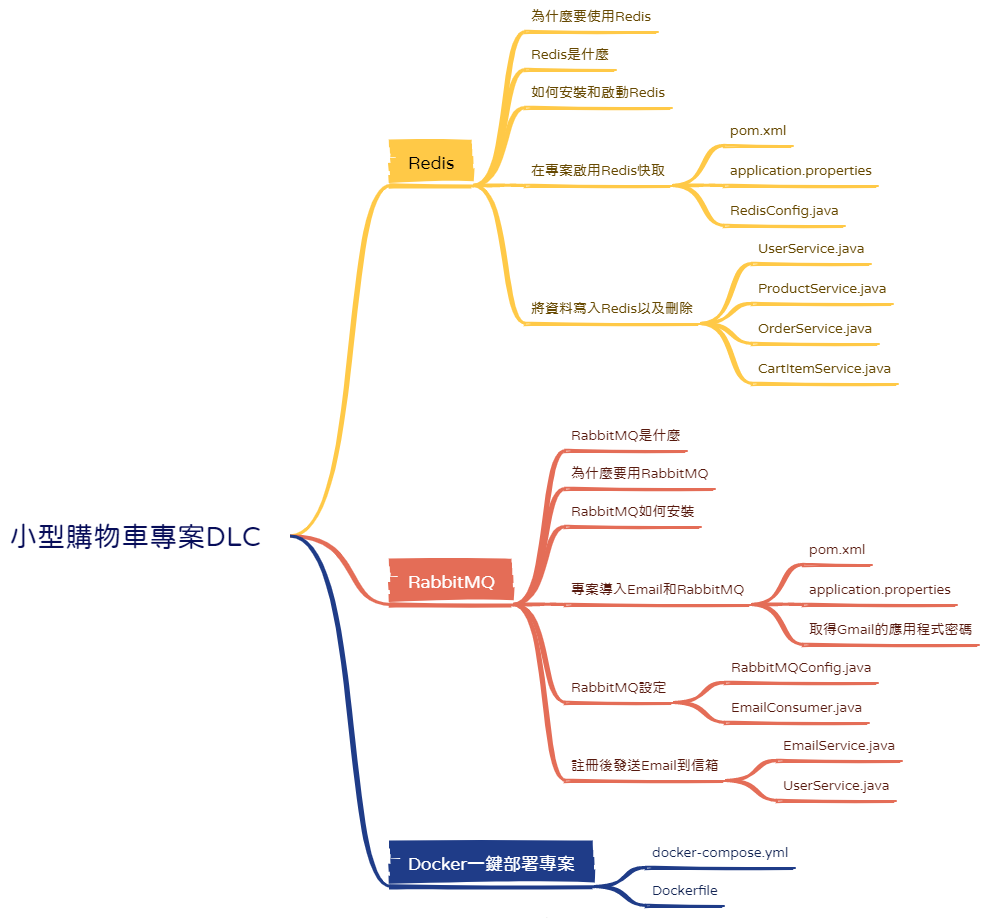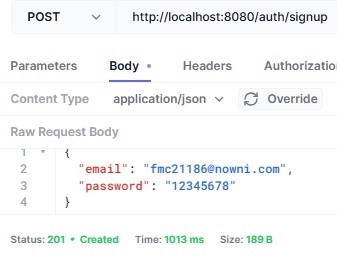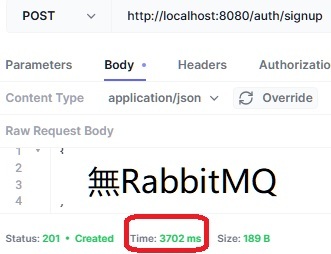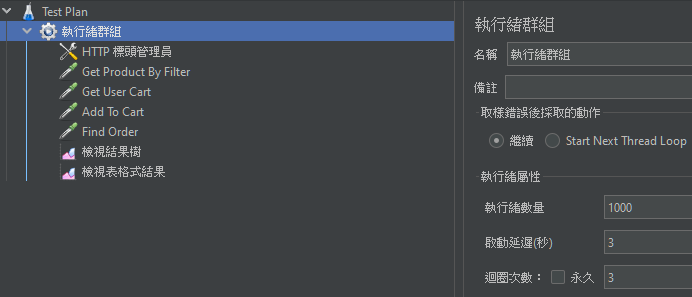先前的部分可以從Day15 觀看,看完Day22後,再來看這一篇,把原本的專案進化成高併發專案。
這篇文章的大綱,提供給大家參考。

需要頻繁讀取資料時,資料庫的讀取速度可能會成為瓶頸,特別是高併發的情況。
使用Redis可以將資料快取,專案就能從RAM(Redis)讀取資料,減少讀取資料庫(MariaDB)的次數,降低延遲。
Redis是一種NoSQL資料庫,可以用於快取和即使存取資料。
跟MariaDB不同,Redis是採用key-value的格式儲存資料,並且使用RAM保存Redis資料庫的內容,因此讀取和寫入的速度極快。
Redis只支援Unix、Linux系統,所以Windows需要使用Docker,才能安裝和啟動Redis。
以下是如何使用Docker安裝Redis的步驟:
docker run --name my-redis -d redis
完成以上步驟後,就能正常使用Redis資料庫。
接下來,我們要讓專案能夠用Redis快取。
pom.xml,添加Redis套件。
<dependency>
<groupId>org.springframework.boot</groupId>
<artifactId>spring-boot-starter-data-redis</artifactId>
</dependency>
在application.properties,加上設定,讓專案能夠連接Redis。
spring.data.redis.port=6379
spring.data.redis.host=localhost
添加Config/RedisConfig.java,用來設定如何使用Redis進行快取。
@Configuration
public class RedisConfig {
@Bean
public RedisTemplate<String, Object> redisTemplate(RedisConnectionFactory factory){
//建立RedisTemplate
RedisTemplate<String, Object> redisTemplate = new RedisTemplate<>();
//使用factory來建立Redis連接
redisTemplate.setConnectionFactory(factory);
//設定ObjectMapper,使用Jackson時需要ObjectMapper
ObjectMapper objectMapper = new ObjectMapper();
//可以接收Object所有的屬性,private的屬性也包含在內
objectMapper.setVisibility(PropertyAccessor.ALL, JsonAutoDetect.Visibility.ANY);
//處理Object的資料形態(Entity),以便Jackson在Deserialize時自動賦予資料形態
objectMapper.activateDefaultTyping(
//允許所有的資料形態
LaissezFaireSubTypeValidator.instance,
//會處理除了Final以外的資料形態
ObjectMapper.DefaultTyping.NON_FINAL,
//將Object轉換成JSON,夾帶Object的資料形態
JsonTypeInfo.As.WRAPPER_ARRAY
);
//Deserialize時忽略未知的屬性,不會直接觸發Exception
objectMapper.configure(DeserializationFeature.FAIL_ON_UNKNOWN_PROPERTIES, false);
//使用上面設定好的objectMapper來建立Jackson2JsonRedisSerializer,用它來Serialize、Deserialize
//把Java的Object轉換成JSON格式(Serialize)、將JSON轉換回Java的Object(Deserialize)
Jackson2JsonRedisSerializer<Object> jackson2JsonRedisSerializer = new Jackson2JsonRedisSerializer<>(objectMapper, Object.class);
//Key會使用StringRedisSerializer,Serialize成字串,或從字串Deserialize
redisTemplate.setKeySerializer(new StringRedisSerializer());
redisTemplate.setHashKeySerializer(new StringRedisSerializer());
//Value會使用jackson2JsonRedisSerializer,Serialize成JSON,或從JSON Deserialize
redisTemplate.setValueSerializer(jackson2JsonRedisSerializer);
redisTemplate.setHashValueSerializer(jackson2JsonRedisSerializer);
//確認對redisTemplate的設定,並啟用
redisTemplate.afterPropertiesSet();
return redisTemplate;
}
@Bean
public RedisCacheManager redisCacheManager(RedisTemplate<String, Object> redisTemplate){
//管理Redis Cache時,不加鎖,提高性能表現
RedisCacheWriter redisCacheWriter = RedisCacheWriter.nonLockingRedisCacheWriter(Objects.requireNonNull(redisTemplate.getConnectionFactory()));
//採用預設的Cache設定,serialize的方式採用redisTemplate中的設定,也就是jackson2JsonRedisSerializer
RedisCacheConfiguration redisCacheConfiguration = RedisCacheConfiguration.defaultCacheConfig()
.serializeValuesWith(RedisSerializationContext.SerializationPair.fromSerializer(redisTemplate.getValueSerializer()));
return new RedisCacheManager(redisCacheWriter, redisCacheConfiguration);
}
}
我們要在Service設定資料的快取。
從Service/UserService.java開始,修改findUserByEmail、findUserById的部分。
如果能夠在快取找到,就立刻回傳。否則,從資料庫取得後存入快取,這樣下次就能更快的讀取。
設定快取過期的時間是30到39分鐘,因為User的內容不會頻繁變化,而且各種操作都需要查詢User,設定較長的過期時間比較適合。
我們使用隨機的過期時間,是為了避免快取同時過期,導致同時要快取所有過期的資料,並且如果同時有湧入大量的請求,就會發生延遲。
那麼設定很長的過期時間,讓Redis一直保存,是否就能避免以上情形。確實能避免,但是會有另一個問題,RAM會被大量占用,造成浪費。
@Service
public class UserService {
//...
private final RedisTemplate<String, Object> redisTemplate;
private final RabbitTemplate rabbitTemplate;
private final int USER_REDIS_CACHE_MINUTES = 30;
public UserService(UserRepository userRepository, PasswordEncoder passwordEncoder, JWTProvider jwtProvider, RedisTemplate<String, Object> redisTemplate, RabbitTemplate rabbitTemplate) {
//...
this.redisTemplate = redisTemplate;
this.rabbitTemplate = rabbitTemplate;
}
public void createUser(User user) throws Exception {
//...
}
public User findUserByEmail(String email){
String cacheKey = "user:email:" + email;
User cachedUser = (User) redisTemplate.opsForValue().get(cacheKey);
if (cachedUser != null) {
return cachedUser;
}
User user = userRepository.findByEmail(email);
if (user != null) {
int random_delay = random.nextInt(10);
redisTemplate.opsForValue().set(cacheKey, user, USER_REDIS_CACHE_MINUTES + random_delay, TimeUnit.MINUTES);
}
return user;
}
public User findUserByJWT(String jwt) throws Exception{
//...
}
public User findUserById(Long id) throws Exception{
String cacheKey = "user:id:" + id;
User cachedUser = (User) redisTemplate.opsForValue().get(cacheKey);
if (cachedUser != null) {
return cachedUser;
}
Optional<User> opt = userRepository.findById(id);
if(opt.isPresent()){
User user = opt.get();
int random_delay = random.nextInt(10);
redisTemplate.opsForValue().set(cacheKey, user, USER_REDIS_CACHE_MINUTES + random_delay, TimeUnit.MINUTES);
return user;
}
throw new Exception("Error: User not found with id: " + id);
}
}
ProductService.java
大部分和UserService.java的部分相同,這邊多了刪除商品時,也從快取刪除資料,避免錯誤讀取到已經被刪除的內容。
@Service
public class ProductService {
//...
private final RedisTemplate<String, Object> redisTemplate;
private final int PRODUCT_REDIS_CACHE_MINUTES = 1;
Random random = new Random();
public ProductService(ProductRepository productRepository, RedisTemplate<String, Object> redisTemplate) {
//...
this.redisTemplate = redisTemplate;
}
public Product addProduct(Product product) {
//...
}
public String deleteProduct(Long id){
productRepository.deleteById(id);
//刪除Redis快取
String cacheKey = "product:" + id;
redisTemplate.delete(cacheKey);
return "Product deleted successfully";
}
public Product getProductById(Long id) throws Exception{
//從Redis取得快取資料
String cacheKey = "product:" + id;
Product cachedProduct = (Product) redisTemplate.opsForValue().get(cacheKey);
if (cachedProduct != null) {
return cachedProduct;
}
//沒有在Redis快取中,必須從資料庫取得
Optional<Product> opt = productRepository.findById(id);
if(opt.isPresent()){
Product product = opt.get();
//存入Redis快取,設定過期規則
int random_delay = random.nextInt(3);
redisTemplate.opsForValue().set(cacheKey, product, PRODUCT_REDIS_CACHE_MINUTES + random_delay, TimeUnit.MINUTES);
return product;
}
throw new Exception("Product not found");
}
public Page<Product> getProductsByFilter(String category, Integer minPrice, Integer maxPrice,
String sort, Integer pageNumber, Integer pageSize) {
//取得第pageNumber(頁數是從0開始),每頁有pageSize個產品
Pageable pageable = PageRequest.of(pageNumber, pageSize);
List<Product> products;
//在快取中尋找
String cacheKey = "products:filter:category:" + category +
":minPrice:" + minPrice +
":maxPrice:" + maxPrice +
":sort:" + sort +
":page:" + pageNumber +
":size:" + pageSize;
List<Product> cachedProducts = (List<Product>) redisTemplate.opsForValue().get(cacheKey);
if (cachedProducts != null) {
//直接將快取的資料放入products
products = cachedProducts;
}
else{
//沒在快取中
//從資料庫取得符合條件的產品
products = productRepository.findProductsByFilter(category, minPrice, maxPrice, sort);
int random_delay = random.nextInt(3);
redisTemplate.opsForValue().set(cacheKey, products, PRODUCT_REDIS_CACHE_MINUTES + random_delay, TimeUnit.MINUTES);
}
//設定從哪裡開始取資料,哪裡結束
int startIndex = (int) pageable.getOffset();//取得指定頁數前有多少資料,等於pageNumber*pageSize
//如果剩餘的資料>=pageSize,就只取pageSize筆。
//如果剩餘的資料<pageSize,將剩下的資料全部取得。
int endIndex = Math.min((startIndex + pageable.getPageSize()), products.size());
//從過濾後的產品列表,截取對應頁數和數量的產品
List<Product> pageContent = products.subList(startIndex, endIndex);
//回傳內容、分頁資訊(頁碼、一頁有幾筆資料)、符合過濾條件的產品數量
return new PageImpl<>(pageContent, pageable, products.size());
}
}
剩下的部分都和前面相同
OrderService.java
@Service
public class OrderService {
//...
private final RedisTemplate<String, Object> redisTemplate;
private final int ORDER_REDIS_CACHE_MINUTES = 1;
Random random = new Random();
public OrderService(OrderRepository orderRepository, RedisTemplate<String, Object> redisTemplate){
//...
this.redisTemplate = redisTemplate;
//...
}
//建立Stripe支付的Session
//import Session時選擇com.stripe.model.checkout
public Session createCheckoutSession(int amount) throws StripeException {
//...
}
//建立訂單
public Order createOrder(String sessionId, Integer totalPrice, String status, String url, Long userId) throws Exception {
//...
}
//使用用戶ID查詢用戶的訂單資訊,查詢時同時更新資料
public List<Order> findOrderByUserId(Long userId) throws Exception {
String cacheKey = "orders:userId:" + userId;
List<Order> cachedOrders = (List<Order>) redisTemplate.opsForValue().get(cacheKey);
if (cachedOrders != null) {
return cachedOrders;
}
List<Order> orders = orderRepository.findOrderByUserId(userId);
List<Order> updated_orders = new ArrayList<>();
for(Order order: orders){
updateOrder(order.getId());
updated_orders.add(order);
}
int random_delay = random.nextInt(3);
redisTemplate.opsForValue().set(cacheKey, updated_orders, ORDER_REDIS_CACHE_MINUTES + random_delay, TimeUnit.MINUTES);
return updated_orders;
}
//更新訂單資訊的付款狀態
public void updateOrder(Long id) throws Exception {
//...
}
}
CartItemService.java
@Service
public class CartItemService {
//...
private final RedisTemplate<String, Object> redisTemplate;
private final int CARTITEM_REDIS_CACHE_MINUTES = 1;
Random random = new Random();
public CartItemService(CartItemRepository cartItemRepository, UserService userService, RedisTemplate<String, Object> redisTemplate) {
//...
this.redisTemplate = redisTemplate;
}
//檢查商品是否在購物車中
public CartItem isCartItemInCart(Cart cart, Product product) {
//...
}
//創建並儲存cartItem到資料庫中
public CartItem createCartItem(CartItem cartItem) {
//...
}
//更新CartItem,重新計算數量和價格,並儲存到資料庫。
public CartItem updateCartItem(Long userId, Long id, CartItem cartItem) throws Exception {
CartItem item = findCartItemById(id);
User user = userService.findUserById(item.getCart().getUser().getId());
//確認發送請求的用戶和購物車的擁有者是同一人
if(user.getId().equals(userId)) {
item.setQuantity(cartItem.getQuantity());
item.setPrice(item.getQuantity() * item.getProduct().getPrice());
//刪除快取
String cacheKey = "cartItem:" + id;
redisTemplate.delete(cacheKey);
}
return cartItemRepository.save(item);
}
//用ID查詢CartItem
public CartItem findCartItemById(Long id) throws Exception {
//尋找快取
String cacheKey = "cartItem:" + id;
CartItem cachedCartItem = (CartItem) redisTemplate.opsForValue().get(cacheKey);
if (cachedCartItem != null) {
return cachedCartItem;
}
//cache miss
Optional<CartItem> optionalCartItem = cartItemRepository.findById(id);
if(optionalCartItem.isPresent()) {
CartItem cartItem = optionalCartItem.get();
int random_delay = random.nextInt(3);
redisTemplate.opsForValue().set(cacheKey, cartItem, CARTITEM_REDIS_CACHE_MINUTES + random_delay, TimeUnit.SECONDS);
return cartItem;
}
throw new Exception("CartItem not found with id : " + id);
}
//移除購物車的商品
public void removeCartItem(Long userId, Long id) throws Exception {
CartItem item = findCartItemById(id);
User user = userService.findUserById(item.getCart().getUser().getId());
User reqUser = userService.findUserById(userId);
if(user.getId().equals(reqUser.getId())) {
cartItemRepository.deleteById(id);
//刪除快取
String cacheKey = "cartItem:" + id;
redisTemplate.delete(cacheKey);
return;
}
throw new Exception("Can't remove another users item");
}
}
下個部分是:完成註冊後,發送通知郵件到信箱。
RabbitMQ的核心功能是充當訊息傳遞的中間層,將訊息送到Queue,Queue根據設定轉發到Comsumers。
RabbitMQ還能透過多種不同類型的Exchanges(交換器),靈活地將消息路由到不同的Queue。
某些耗時的操作會影響專案的回應速度,使用RabbitMQ可以改善。
以用戶註冊為例,當新用戶註冊後,系統會發送Email到信箱。
如果沒有RabbitMQ,用戶需要等待Email的流程結束後,才能繼續操作,導致使用者的體驗不佳。
導入RabbitMQ後,可以將耗時的操作(發送Email)轉移到Queue中,用戶就能立刻得到註冊成功的結果。
發送Email則是由Comsumer非同步處理,避免系統被長時間阻塞。
雖然Windows可以直接安裝RabbitMQ,但是需要另外安裝Erlang。
建議使用Docker安裝比較容易。
docker run -it --rm --name rabbitmq -p 5672:5672 -p 15672:15672 rabbitmq:4-management
pom.xml,添加Mail、AMQP套件。
<dependency>
<groupId>org.springframework.boot</groupId>
<artifactId>spring-boot-starter-mail</artifactId>
</dependency>
<dependency>
<groupId>org.springframework.boot</groupId>
<artifactId>spring-boot-starter-amqp</artifactId>
</dependency>
修改application.properties,添加email和RabbitMQ的設定。
spring.mail.host=smtp.gmail.com
spring.mail.port=587
spring.mail.username=${GMAIL_ADDRESS}
spring.mail.password=${GMAIL_PASSWORD}
spring.mail.properties.mail.smtp.auth=true
spring.mail.properties.mail.smtp.starttls.enable=true
spring.rabbitmq.host=localhost
spring.rabbitmq.port=5672
spring.rabbitmq.username=guest
spring.rabbitmq.password=guest
在繼續之前,我們先取得應用程式密碼。
這樣我們就能使用Gmail免費發送郵件。
建立Config/RabbitMQConfig.java,設定RabbitMQ的Queue的Exchange。
@Configuration
public class RabbitMQConfig {
public static final String QUEUE_NAME = "emailQueue";
public static final String EXCHANGE_NAME = "emailExchange";
@Bean
//RabbitMQ產生持久化的Queue,可以依序完成要求的功能(送Email)
public Queue queue() {
return new Queue(QUEUE_NAME, true);
}
@Bean
//RabbitMQ Exchange,接收Producer的要求,送到對應的Queue中
public TopicExchange exchange() {
return new TopicExchange(EXCHANGE_NAME);
}
@Bean
//將Queue綁定到指定的Exchange,當routingKey相同時,才會分到Queue中
public Binding binding(Queue queue, TopicExchange exchange) {
return BindingBuilder.bind(queue).to(exchange).with("email.routing.key");
}
}
建立Service/EmailConsumer.java,設定消費者從Queue接收到訊息時的動作。
@Component
public class EmailConsumer {
private final EmailService emailService;
public EmailConsumer(EmailService emailService){
this.emailService = emailService;
}
//當指定的Queue接收到訊息時,會自動執行裡面的內容
@RabbitListener(queues = RabbitMQConfig.QUEUE_NAME)
public void receiveMessage(String to) {
//發送郵件
emailService.sendSimpleEmail(to);
}
}
新增Service/EmailService.java,處理發送Email的細節。
@Service
public class EmailService {
private final JavaMailSender javaMailSender;
public EmailService(JavaMailSender javaMailSender){
this.javaMailSender = javaMailSender;
}
//處理送出Email的細節
public void sendSimpleEmail(String to) {
Dotenv dotenv = Dotenv.load();
//編寫郵件內容
SimpleMailMessage message = new SimpleMailMessage();
//寄到哪邊
message.setTo(to);
//Email主旨
message.setSubject("Welcome to Shopping Cart, " + to + " !");
//Email內容
message.setText("Thank you for choosing Shopping Cart. We look forward to serving you and making your shopping experience enjoyable.\n" +
"Best regards,\n" +
"The Shopping Cart Team");
//寄件人是誰
message.setFrom(dotenv.get("GMAIL_ADDRESS"));
//送出Email
javaMailSender.send(message);
}
}
修改UserService.java,在註冊成功時將發送Email透過Exchange傳送到對應的Queue。
@Service
public class UserService {
//...
private final RabbitTemplate rabbitTemplate;
public UserService(UserRepository userRepository, PasswordEncoder passwordEncoder, JWTProvider jwtProvider, RedisTemplate<String, Object> redisTemplate, RabbitTemplate rabbitTemplate) {
//...
this.rabbitTemplate = rabbitTemplate;
}
public void createUser(User user) throws Exception {
//找尋資料庫中是否有使用同樣的email的用戶
User isEmailExists = userRepository.findByEmail(user.getEmail());
//如果有,代表這個email被註冊了
if(isEmailExists != null) {
throw new Exception("Error: Email is already registered.");
}
User createdUser = new User();
createdUser.setEmail(user.getEmail());
//將密碼加密,提升安全性
createdUser.setPassword(passwordEncoder.encode(user.getPassword()));
//寄出恭喜註冊的郵件到註冊Email
sendEmail(user.getEmail());
userRepository.save(createdUser);
}
//使用RabbitMQ完成發出Email的功能
public void sendEmail(String to) {
rabbitTemplate.convertAndSend(RabbitMQConfig.EXCHANGE_NAME, "email.routing.key", to);
}
//...
}
註冊的結果是這樣

覺得延遲很嚴重?那來看看沒有RabbitMQ的情形,延遲更長了3702ms。

等1秒還可以接受。等3秒的話,我想大部分的人會認為是不是當機了。
安裝MariaDB、Redis、RabbitMQ的過程,有些人可能認為很困難。
現在,我們使用Docker打包一切,從環境設定到自動編譯和啟動。
只要準備好專案的原始碼和.env,然後專案的根目錄編寫docker-compose.yml、Dockerfile,就能自動完成這一切。
我們先完成docker-compose.yml,處理環境(MariaDB、Redis、RabbitMQ)相關的設定。
services:
db:
#使用最新的mariadb穩定版
image: mariadb:latest
#將容器取名為mariadb_book
container_name: mariadb_cart
#意外停止後,會自動重新啟動
restart: always
environment:
#設定mariadb root的密碼
MARIADB_ROOT_PASSWORD: 12345678
#建立資料庫
MARIADB_DATABASE: cart_db
#使用的port,AAAA:BBBB,AAAA是外部連接容器使用的port,BBBB是容器內部的port
ports:
- "3306:3306"
#將Mariadb的資料存入這個位置,確保容器重新啟動時,資料庫的資料不會消失
volumes:
- db_data:/var/lib/mysql
#redis相關的設定
redis:
image: redis:latest
container_name: redis_cart
restart: always
ports:
- "6379:6379"
rabbitmq:
image: rabbitmq:4-management
container_name: rabbitmq_cart
restart: always
ports:
- "5672:5672"
- "15672:15672"
environment:
RABBITMQ_DEFAULT_USER: guest
RABBITMQ_DEFAULT_PASS: guest
volumes:
- rabbitmq_data:/var/lib/rabbitmq
#專案相關的設定
app:
#使用同目錄下的Dockerfile,來建立app容器
build: .
container_name: java_cart
restart: always
ports:
- "8080:8080"
#spring專案設定
environment:
#改寫application.yaml中的spring: datasource: url:
#db是資料庫容器的名稱,這邊不能再使用localhost,會無法連接
SPRING_DATASOURCE_URL: jdbc:mariadb://db:3306/cart_db
SPRING_DATASOURCE_USERNAME: root
SPRING_DATASOURCE_PASSWORD: 12345678
#改寫application.yaml中的spring: data: redis: host:
#redis是容器的名稱
SPRING_DATA_REDIS_HOST: redis
#RabbitMQ設定
SPRING_RABBITMQ_HOST: rabbitmq
volumes:
db_data:
rabbitmq_data:
Dockerfile,完成自動編譯並執行的設定。
#使用maven
FROM maven:3-amazoncorretto-17 AS build
#將目錄下的檔案複製到app資料夾中
COPY . /app
#設定之後執行操作的位置
WORKDIR /app
#使用maven打包,不經過測試
RUN mvn clean package -DskipTests
#使用amazoncorretto
FROM amazoncorretto:17-alpine
#從上面build的部分取得jar,複製到新容器中
COPY --from=build /app/target/*.jar app.jar
#將.env複製到容器中
COPY ./.env .env
#使用port 8080
EXPOSE 8080
#啟動Spring Boot專案
ENTRYPOINT ["java", "-jar", "app.jar"]
我們就能使用一行命令,完成環境並啟動專案。
docker-compose up
使用JMeter來測試高併發專案
設定1000*4(Get Product By Filter、Get User Cart、Add To Cart、Find Order)*3=12000個Request,對於專案是個很大的挑戰。

測試的結果,我們先看最大的延遲是多少,從下圖可以得知為2845ms,在這樣的壓力下能得到這種結果已經很不錯了,而且是100%的通過,沒有任何錯誤。

最低的時候,可以達到5ms的低延遲表現。

我們的高併發專案通過了壓力測試,並且是在17秒內湧入12000個Request的情況下,驗證它擁有處理高併發的能力。
